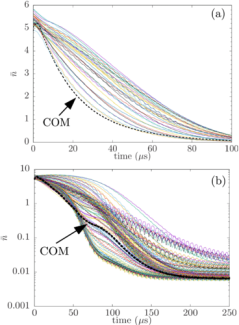Using analogies from cavity QED to engineer steady-state spin synchronization in a trapped-ion system.
Cooling curves for all the drumhead modes of a trapped-ion crystal.
Ultranarrow-linewidth atoms coupled to a lossy optical cavity mode synchronize, i.e., develop correlations, and exhibit steady-state superradiance when continuously repumped. This type of system displays rich collective physics and promises metrological applications. These features inspire us to investigate if analogous spin synchronization is possible in a different platform that is one of the most robust and controllable experimental testbeds currently available: ion-trap systems. We design a system with a primary and secondary species of ions that share a common set of normal modes of vibration. In analogy to the lossy optical mode, we propose to use a lossy normal mode, obtained by sympathetic cooling with the secondary species of ions, to mediate spin synchronization in the primary species of ions. Our numerical study shows that spin-spin correlations develop, leading to a macroscopic collective spin in steady state. We propose an experimental method based on Ramsey interferometry to detect signatures of this spin synchronization; we predict that correlations prolong the visibility of Ramsey fringes, and that population statistics at the end of the Ramsey sequence can be used to directly infer spin-spin correlations.






